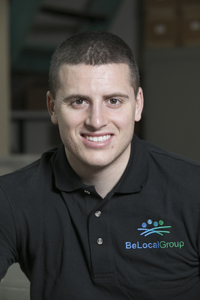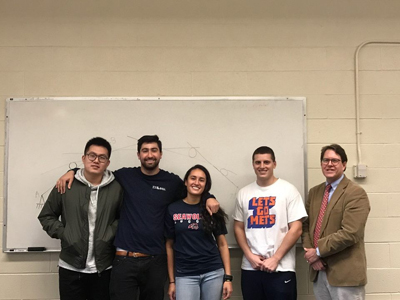Researcher of the Month
April 2018
 Johnny Donza
Johnny Donza
Civil Engineering major, Class of 2018
Research Mentor: Dr. Harold Walker, Civil Engineering; Additional project advisor: Dr. Ryan Giles, Civil Engineering (current); Dr. Sherif Abdelaziz, Civil Engineering (previous).
A highlight of the annual URECA Undergraduate Research Celebration is seeing the exhibition of Senior Design projects from the College of Engineering and Applied Sciences (CEAS). That is especially true this year, as the URECA event will feature an exciting collaboration between Stony Brook University and the BeLocal organization. Over a dozen senior design projects that address real engineering needs and challenges for people living in Madagascar are currently underway. Ranging from rice processing/storage to rat control to briquette manufacturing, these projects have been thoughtfully developed for senior CEAS students from information gathered by recent Stony Brook graduates Acacia Leakey and Leila Esmailzada last summer. And projects such as the BeLocal-bridge project have already generated lots of excitement.
 For Johnny Donza, team leader of The BeLocal-bridge project, the capstone CEAS senior design experience
has been intense, challenging, rewarding; and has offered a unique appeal: “For senior design, you could be involved with a project just for credit, or just to
pass the class. But this project was more than that. They are actually looking to
build it.” Together with his fellow Civil Engineering team majors Manuela Corcho, Luke Papazian
and Yuxin Xia – all working under the direction of Prof. Harold Walker, Chair of the Civil Engineering
Department – Johnny has devoted much of his time over the past year to an innovative bamboo bridge
design, already proposed for use in actual construction this summer in Madagascar.
“We are really excited about our design!"
For Johnny Donza, team leader of The BeLocal-bridge project, the capstone CEAS senior design experience
has been intense, challenging, rewarding; and has offered a unique appeal: “For senior design, you could be involved with a project just for credit, or just to
pass the class. But this project was more than that. They are actually looking to
build it.” Together with his fellow Civil Engineering team majors Manuela Corcho, Luke Papazian
and Yuxin Xia – all working under the direction of Prof. Harold Walker, Chair of the Civil Engineering
Department – Johnny has devoted much of his time over the past year to an innovative bamboo bridge
design, already proposed for use in actual construction this summer in Madagascar.
“We are really excited about our design!"
Johnny Donza’s specialization as a Civil Engineering major is in Structural Engineering
and Construction Materials. Prior to his senior year, Johnny was a research assistant
for Prof. Sherif Abdelaziz in the Sustainable Geotechnics Laboratory, assisting in studies on the effect of geothermal energy on asphalt in cold temperatures,
and on how engineered bacteria-induced enzymes can improve soil properties. Johnny
is also currently serving as Captain of the Concrete Canoe Build Competition team
which is creating a 20-foot long canoe for an upcoming competition in NJ. In the summers,
he has interned at Turner Construction Company in NYC, and at D&B Engineers and Architects
in Woodbury, NY.
Following graduation, Johnny hopes to travel to Madagascar this summer to build the bridge; ; he will then be pursuing a Master of Science Degree in Civil Engineering and Engineering Mechanics with a concentration on structures at Columbia University. As a junior, Johnny was selected to participate in the American Society of Civil Engineers Workshop for Student Chapter Leaders (Newark NJ) last January; and has also served as a Peer Mentor for CEAS. Johnny is from Long Island and attended Massapequa High School prior to coming to Stony Brook University. Below are excerpts from his interview with Karen Kernan, URECA Director.
The Interview:
Karen. What is your current Senior Design project? How did you get involved?
Johnny. So in the beginning of the year, our professor gave us a whole list of different senior
design projects to choose from. It just so happened that I got picked for the BeLocal
bridge project, my first choice . . . I was interested in doing the project to begin
with because it’s quite different than the other senior design projects. For senior
design, you could be involved with a project just for credit, or just to pass the
class. But this project was more than that. They are actually looking to build it.
That’s why I wanted to get involved in the first place. Before we gave our senior
design project preferences, BeLocal had made a presentation on who they were, what
the projects are really about it. And I was really captivated by what they had to
say.
Tell me more about your bridge design/project.
Basically, the site in which we are going to construct our bridge is approximately
a 2 meter wide stream. The bridge is needed to help people get across so that they
can buy/sell goods at the local markets. The project site is on the outskirts of a
village named Mandrivany, a rural community. Currently, people would build bridges
by taking a log and laying it across the stream. That method is a temporary construct,
because the log will snap. And during monsoons, the logs would get washed away.
What are some of the specific challenges to this project?
Really the design challenge is using this specific material we’ve chosen to use—the
bamboo. It’s highly variable in its properties. Also, in our coursework, we’ve learned
how to design with concrete and steel– typical construction materials. But the steel available in Madagascar is mainly made
out of scrap metal so it’s not very reliable. We really wanted to come up with a design
that would use bamboo because it is so plentiful, as opposed to hardwood, for example,
which is not a good option due to deforestation. Our project is not without its unique
challenges – for instance, performing the structural analysis on the design. The way
the loads are distributed are very complex – they take abnormal load paths that typically
you won’t see in a regular construction project, with steel design.
Are you pleased with the progress you’ve made so far?
We are really excited about our design! I don’t have an official drawing to show you
yet-but here is a hand-drawing. {see photo} As you can see, our design uses a long piece of bamboo that would span across the
entire bridge and basically be anchored to these foundations here. We have our original
DaVinci arch that is going to be the supporting structure. We’ll have bamboo poles
going downwards to each of these transverse members to help transfer the load from
the deck to the bridge structure.
What has been the most fun aspect of being involved with this project?
Just the whole design concept... I remember when we initially started, Prof. Walker
advised us to stay away from the arch design and think about a simple girder bridge.
But we found the challenge in this design to be more exciting and we wanted to try
it. The way bamboo works is that when it’s loaded perpendicularly, it’s weaker. When
it’s loaded axially, it’s significantly stronger. So this design we’ve worked on kind
of takes advantage of the structural properties of bamboo. And also this is a self-supporting
bridge. ...Our professors have given us positive feedback that we have been able to
carry the project forward this far. … And I like the flexibility of the design. Just
the appearance of the design is cool. It’s a unique shape. It’s different from what
most bridges would typically look like.
This project must have been a huge learning process for all of you.
We certainly learned a lot about working with bamboo! For instance, there’s a curing
process. You can’t just cut down bamboo and begin building. You have to cure it to
get the resin inside the bamboo fibers out. That significantly increases the strength
and its structural properties. We even spent about a month of time dedicated to testing
bamboo on campus ….We soon realized that the bamboo properties are highly variable
and unfortunately, much of that information we collected ended up being unusable.
…We’ve also consulted with a company called Bamboo Basics to get more Madagascar site-specific
data on bamboo construction.
It must be satisfying to know that the project may come to fruition.
Yes. We actually had interviews yesterday with BeLocal. They are trying to build a
team of people to go to Madagascar to construct certain projects this summer. And
they’ve expressed interest in constructing our specific bridge. We’ve been meeting
with them, talking about how we would go about construction if we were to go to Madagascar. If
I get chosen, I ‘ll definitely be going. I think it would be a great experience.
One important consideration for us while working on our design was to make our design adaptable. We haven’t been to the site ourselves – so we had to make sure our design could be changed easily. For example, if we preset our foundations, we might have our foundation too high…With our current design, we’ll be able to adjust these vertical pieces to account for those errors in construction.
What skills have you most developed from doing senior design?
Definitely project management skills. It’s a lot of work. There are other things that you have to learn – task delegation, things of that nature. I’ve learned about different materials other
than conventional steel and concrete that I probably wouldn't have learned about in
such depth from other coursework. I’ve also learned how to use different computer
skills. In designing our foundation, I was able to write a Matlab code that analyzes
the soil properties at various values. We also had to learn structural analysis software
to help design the bridge. Prof Ryan Giles helped us out a lot with that.
Are there particular challenges that you hadn’t experienced before or hadn't anticipated?
As the team leader, you have different challenges, different responsibilities. Let’s
say if someone were to get sick or couldn’t do a portion of the project…it not only
delays the schedule but it also means that I may have to pick up that work to keep
the project on schedule. With certain unexpected events, I have to take control of
the situation and correct it to keep the project moving forward.
How do you feel your team did overall?
If it wasn’t for my team members, I don’t think we would have been able to get this
far in the project. We all helped each other out throughout the course of the project.
What advice would you give to other students about senior design?
Definitely select a project that you are going to feel passionate about, one that
will ultimately help you continue on with the challenges you will face in your design
project. What this project has helped me with is getting ready for the real world.
You soon find out that most design projects don’t go exactly according to plan. There
are things that come along that you have to adapt to. You’re definitely going to see
some challenges as you go through it. Also, everyone always says senior year is generally
"more relaxed.” Not for me! I didn't find it that way at all....So my advice is: Get
ready to work!
